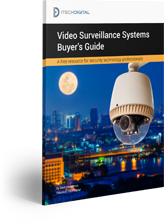Camera and Image Capture
Cameras are the devices that actually capture the image and transmit it to the DVR/NVR. Light from a source like a light bulb or the Sun passes through a lens onto a sensor and then is transmitted back to the DVR or NVR.
Body (Type)
The body of the camera is the part you typically see. They can vary in size and shape based on application. Common types include: dome, box, bullet and Environmental. The body of a camera does not determine its functionality. Dome cameras are the most common. Box cameras usually have interchangeable lenses that allow for versatility. Bullet cameras are shaped like a pop can and may have an adjustable lens. Environmental cameras are sealed and commonly used in freezers or coolers.
Lens
The lens is the optical part of the camera. It collects light and directs it to the sensor. Lenses are measured in millimeters. The smaller the number the more wide angle the lens. The larger the number the more zoomed in the lens is. Typical CCTV cameras are about 3mm and are fixed (cannot be adjusted). A lens that would zoom across a parking lot (telephoto) would be 100mm. Some lenses can be adjusted from one number to another and are called varifocal (example 5-50mm). The lens determines the area of coverage or Field of View (FOV). There are calculators available that change field of view into usable measurements.
Iris
Just like in the human eye, an iris is a mechanism that controls the amount of light that reaches the sensor. Cameras can have either a fixed iris, that does not change, or an Auto-Iris, that does change depending on the amount of light available.
Sensor
The sensor is the part of the camera that turns optical light into electronic signals. There are two types CCD and CMOS. Analog cameras are almost all CCD but IP cameras can be CCD or CMOS. Sensors are often called chips and typically manufactured by one of a few large companies like Sony or Panasonic.
PTZ
Pan Tilt and Zoom. PTZ cameras have motors that allow them to be moved remotely. iTech Digital’s DVRs are PTZ capable.
Zoom
There are two types of zooming technology. The first is an Optical Zoom. This consists of moving a lens in the camera to make an object “larger” in the frame. Think telescope. Optical zooming has the advantage of not losing any quality but has two key disadvantages. First it must be done at the time of capture (cannot be done after the image is captured. Second, cameras with zoom lenses that can be controlled remotely (PTZ) are more expensive and more likely to wear out quickly. Digital zooming is the enlarging of an image using software. It can be done after the fact and, with a high enough resolution, can suitably enlarge images for better viewing. Contrary to popular belief it is rarely able to “enhance” the image. The image that was captured at the time of recording is the only data that can be used. The more you digitally zoom, the more you will see the individual pixels.

